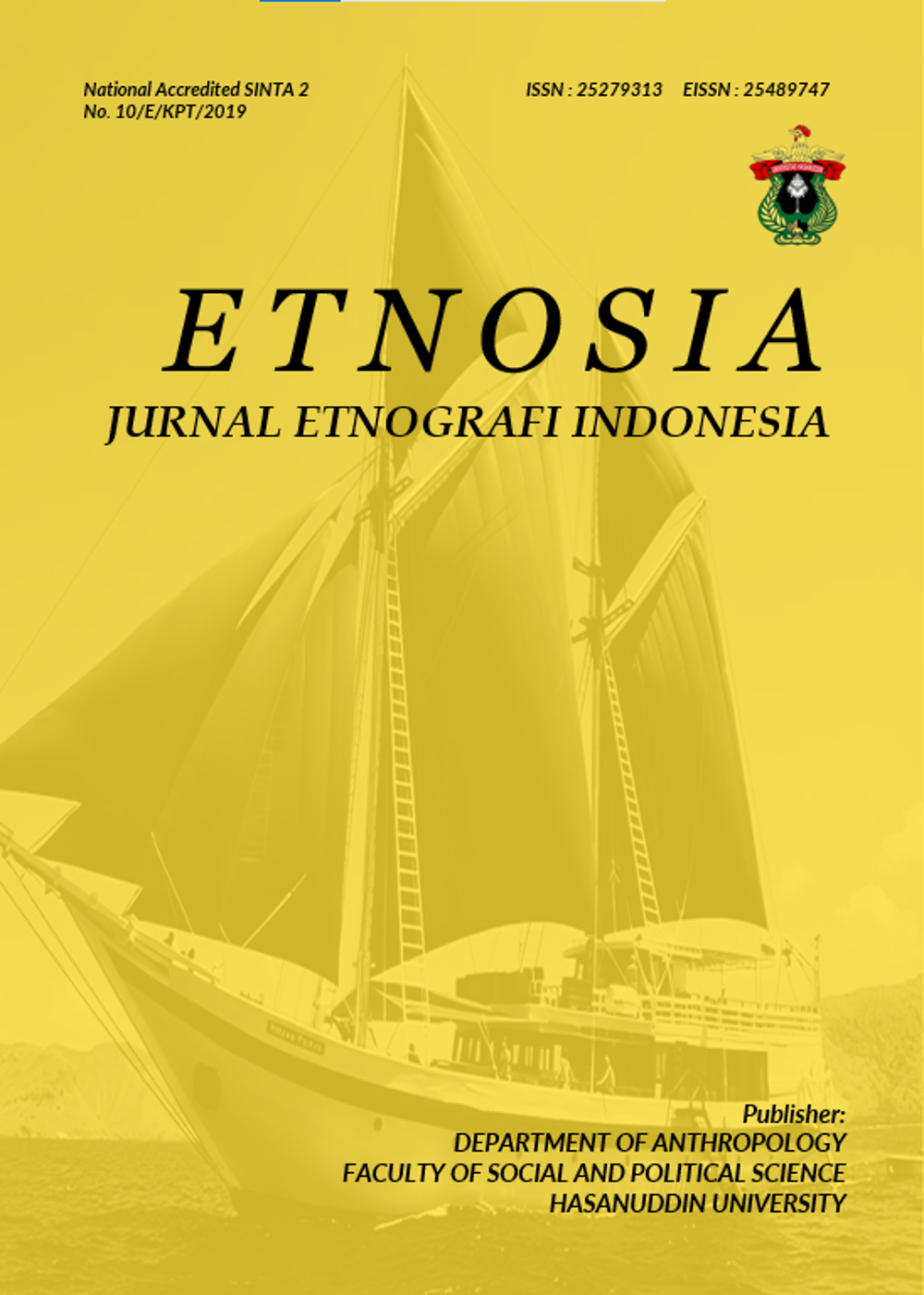Abstract
This article aims to explain the symbolic meaning in the process of making the traditional sandeq boat of the Mandar people. The data collection process was carried out from April to June 2017. Data were obtained through in-depth interviews with 6 purposively selected expert informants, as well as direct observation in the field. The results of this study indicate that the ritual that accompanies the making of the traditional sandeq boat is seen in three main stages, namely: at the beginning of boat building, in the process of making boats, and launching boats into the sea. The meaning contained in the implementation of the ritual is the hope that it will always be given safety in using the boat. In addition, the ritual also intends to ask for abundant sustenance from the process of going to sea later. The religious value of the Mandar people is clearly seen from every stage of the ritual carried out, using mantras and prayers as verbal messages adopted from the Quran and with Islamic nuances. In addition, nonverbal messages in the ritual of making sandeq boats are centered on the use of ussul or the knowledge system of the local community which is carried out with actions or symbolic objects to show their hopes or desires.References
Alimuddin, M. R. (2013). Sandeq :Perahu Tercepat Nusantara. Yogyakarta: Ombak.
Bungin, B. (2006). Sosiologi Komunikasi: Teori, Paradigma, dan Diskursus. Teknologi Komunikasi di masyarakat. Jakarta: Kencana pernada Media. Group. Jakarta: Kencana Prenada Media Grup.
Dali, Z. (2016). Hubungan Antara Manusia, Masyarakat, Dan Budaya Dalam Perspektif Islam. Nuansa, IX(1), 47–57. Diambil dari https://ejournal.iainbengkulu.ac.id/index.php/nuansa/article/viewFile/373/320
Darmawan, K. Z. (2008). Penelitian Etnografi Komunikasi: Tipe dan Metode. Mediator: Jurnal Komunikasi, 9(1), 181–188. https://doi.org/10.29313/mediator.v9i1.1142
Fatanti, M. N., & Tuti, S. N. T. (2020). Interpretation of Nyadran Sonoageng Ritual as the Form of Ritual Communication of Sonoageng Villagers, Nganjuk Regency. Communicator, 12(1). https://doi.org/10.18196/jkm.121036
Fitrah, A. N., Wahyuni, S., Idris, N., & Bahfiarti, T. (2018). Analysis of Symbolic Meaning of Shipping Technique and Navigation: Case Study of Sandeq Boat of the Mandar Tribe, 165(Iccsr), 316–320. https://doi.org/10.2991/iccsr-18.2018.70
Hendro, E. P. (2020). Simbol: Arti, Fungsi, dan Implikasi Metodologisnya. Jurnal Ilmiah Kajian Antropologi, 3(2), 160.
Ismail, A. (2012). Agama Nelayan “Pergumulan Islam Dengan Budaya Lokal.” Yogyakarta: Pustaka Pelajar.
Juliadi, Cangara, H., & Bahfiarti, T. (2018). Semiotika Simbol Komunikasi Non Verbal Jamaah Annadzir Dalam Menyebarluaskan Ideologi Islam Di Kabupaten Gowa. KAREBA: Jurnal Ilmu Komunikasi, 7(1), 150–157.
Kasitowati, R. D. (2011). SANDEQ DAN ROPPO Kearifan Lokal Suku Mandar Pesisiran, Sulawesi Barat. Sabda : Jurnal Kajian Kebudayaan, 6(1), 63. https://doi.org/10.14710/sabda.v6i1.13305
Kriyantono, R. (2012). Teknik Praktis Riset Komunikasi (1 ed.). Jakarta: Kencana Prenada Media Grup.
Kusuma, A., Putri Purbantina, A., Nahdiyah, V., & Khasanah, U. U. (2020). A Virtual Ethnography Study: Fandom and Social Impact in Digital Era. ETNOSIA : Jurnal Etnografi Indonesia, 5(2), 238–251. https://doi.org/10.31947/etnosia.v5i2.10898
Pujiwidodo, D. (2016). TRADISI SLUP-SLUPAN Akulturasi Islam dan Budaya Jawa di Rembang Jawa Tengah. Sabda : Jurnal Kajian Kebudayaan, 11(2), 53–64. https://doi.org/10.14710/sabda.v11i2.16046
Rahmawati, R., Nurhadi, Z. F., & Suseno, N. S. (2017). Makna Simbolik Tradisi Rebo Kasan. Jurnal Penelitian Komunikasi, 20(1), 61–74. https://doi.org/10.20422/jpk.v20i1.131
Setiadi, E. M., Hakam, K. A., & Effendi, R. (2013). Ilmu Sosial & Budaya Dasar. Jakarta: Kencana Prenada Media Grup.
Syan, M., & Hamdat, S. (2019). Manca’: A Study of the Martial Arts’ Symbol as Makassar Cultural Identity in Gowa, South Sulawesi. ETNOSIA : Jurnal Etnografi Indonesia, 4(2), 193. https://doi.org/10.31947/etnosia.v4i2.7670

This work is licensed under a Creative Commons Attribution-NonCommercial 4.0 International License.
Copyright (c) 2021 ETNOSIA : Jurnal Etnografi Indonesia





